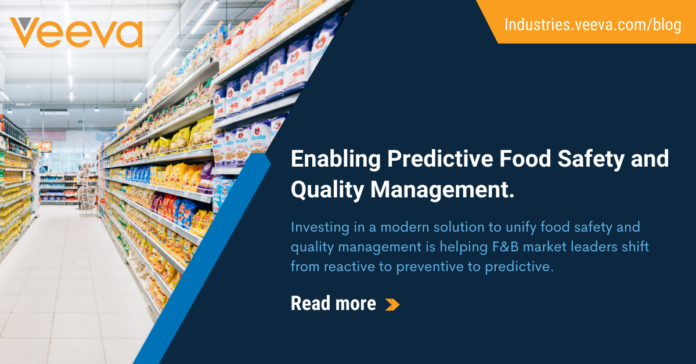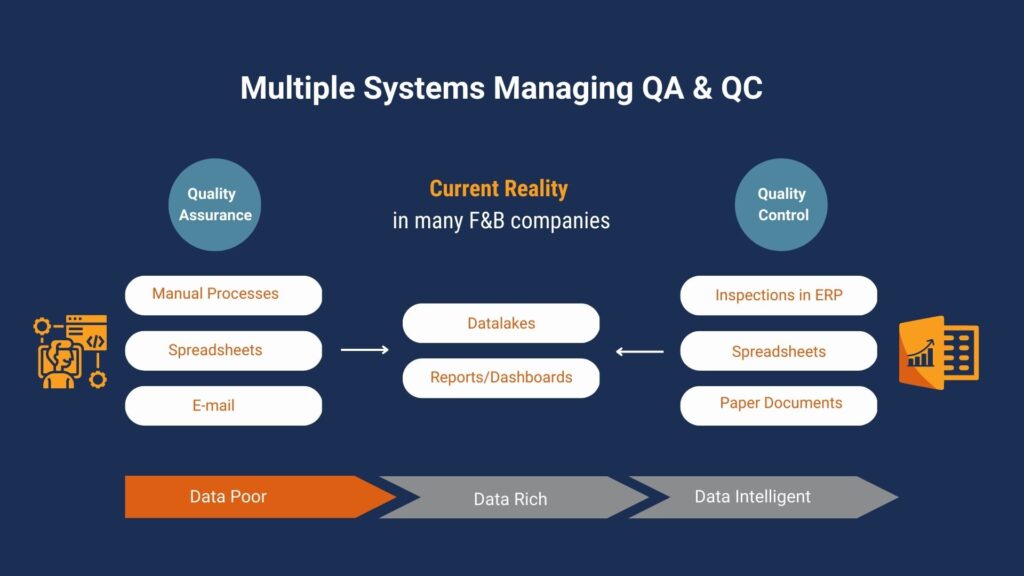
Sponsored by Veeva Systems
By Geert van Kempen and Mark Bräsler
It’s the news that every food and beverage (F&B) manufacturer dreads – people are getting sick after consuming your product.
Employees scramble to shut down production lines and investigate the source. Leaders are demanding to understand the scale of the issue, faster than confident answers can be provided. Should we institute a recall? Of all the teams mobilized during these kinds of events, the news hits hardest for food safety and quality. Wondering what they missed. Could this have been avoided?
In the F&B industry, food safety and quality are imperatives. They are the bedrock of consumer and public trust. They take years of consistent performance to earn, and can be lost in an instant.
Until recently, most teams responsible for managing these critical processes were using yesterday’s technology – disparate spreadsheets, email, outdated on-premise software, even paper files.
Leading F&B companies are now modernizing food safety and quality management with unified, cloud-based solutions that are purpose-built to allow them to evolve their approach from reactive to preventative, and ultimately to predictive. These initiatives promise to enable more streamlined operations and better business outcomes, as well as avert brand reputation damage and consumer suffering.
Unnecessary risk: The cost of reactive food safety and quality management
There is consensus among F&B leaders that food safety is of the highest importance. However, at most companies, that prioritization hasn’t translated into investments to modernize the systems that manage these processes. This introduces avoidable risk into these critical business areas and for consumers.
Inside the typical F&B manufacturer, the functions of food safety, quality, and occupational safety are managed using disparate systems that lack connectivity and require manual user input to communicate information transfers. Data quality, and access to data, is poor. The amount of work required to maintain the status quo forces companies into reactive mode, often only recognizing food safety and quality events after they’ve caused harm.
Following the business operations disruptions of the past few years, some forward-thinking food safety and quality leaders have recognized how untenable these outdated systems are for such critical business processes. Additionally, the workforce generation that set up and is most comfortable working in these systems is retiring. Meanwhile, new hires are increasingly vocal that these disjointed processes and disparate systems are inconsistent with stated organizational values and don’t set team members up for success.
The most common food safety and quality management systems at companies today make it nearly impossible to comply with leadership requests to make data-driven decisions, proactively identify trends, or provide visibility. To drive better business outcomes and stay ahead of their competition, it’s past time to modernize and unify.
How unified systems set the foundation for predictive food safety and quality
In our work with leaders in the F&B industry, we’ve seen many recognize that technology solutions and digitization are required to move from reactive food safety and quality management to a more proactive and ultimately predictive approach. Achieving this evolution requires many elements, and at its foundation is having the right data.
If you’re like most of your peer companies, your food safety and quality data is spread across multiple, disparate systems, and the context that brings meaning to that data is not harmonized.

Without bringing key food safety and quality documents, data, and processes into a single context on a unified platform, it’s impossible to deploy the modeling necessary to achieve insight-driven predictive quality.
For example, when one of the authors worked in quality management at a top global CPG company, the team asked themselves if they could look upstream in their supply chain to identify risks that would increase the likelihood of a marketplace incident that would rise to the level of a product recall.
They looked at supplier non-conformances and non-conformances in manufacturing environments as “early warning” signals to indicate that facilities were at increased risk for a marketplace incident should these non-conformances go unnoticed in the future. After tremendous effort pulling together data from many sources and systems, the team did identify trends and patterns for early risk signals and proved the principle – events upstream in the manufacturing chain could identify increased risks of non-conformances downstream, and perhaps forewarn product recall.
But in a “data poor” environment, automation was not feasible due the misalignment of the data. The prospect of marshaling the resources necessary to replicate this type of analysis, or ongoing monitoring of these indicators, was simply infeasible. This predictive, risk-based approach could only be implemented if and when all data was captured in the same systematic way, embedded in the same master data, across the enterprise.
The importance of establishing end-to-end visibility of quality information
Beyond data quality, investing in technology to unify quality assurance and quality control enables end-to-end visibility on quality information. Unifying these siloed processes, management systems and data sources frees up valuable employee time for more strategic tasks, streamlines operations, and ultimately drives better business outcomes.

In a unified system as illustrated in the diagram above, users can securely perform all their procedures, and associated data is captured in a consistent, structured environment. This can also be integrated with related sources of truth like specification and ERP systems. Additionally, data from external stakeholders like co-manufactures and suppliers can be securely stored and accessed for enhanced collaboration, traceability, and visibility.
You may be wondering about the value of managing quality and food safety in a single solution. This is a reflection of the intertwined nature of joint processes, while still preserving the differentiation of quality and food safety events and enabling rapid action based on incident severity.
Establishing a unified food safety and quality management system like this is the critical foundational step for transforming from a data poor to a data rich environment, laying a strong foundation to bring about predictive quality and food safety.
Single source of truth unlocks collaboration, insights
If this vision inspires you, prepare yourself for the final stage in the progression from reactive to preventative to predictive – becoming data intelligent and benefiting from your data becoming the new “appreciating asset.”

Such a unified system is set up to automatically capture and analyze structured data from a variety of sources. This enables organizations to finally “connect the dots” to identify risks and trends in real-time, offer transparency to all relevant stakeholders, and facilitate proactive steps to head off future issues. Over time, insights from the ever-increasing data pool become increasingly confident and more valuable to the organization. Insights can be turned into learnings that help sharpen quality assurance and quality control processes, leading to the continuous improvement we all strive for.
What could this look like in practice? Let’s take an example present in any F&B company – processing certificates of analysis (CoAs) from suppliers. Today, this is usually a labor intensive process involving manual verification and data transcription, and then the paper (and its data) are stored in binders. The amount of effort an enterprise-sized organization spends on this manual process is significant, in the range of ~75 FTE per million CoAs.
With a modern, AI-powered food safety and quality management solution like Veeva’s, the data from each CoA can be automatically extracted and converted into structured data, digitally available, that can then be leveraged for analysis like material and supplier performance. Insights from this analysis enable data-based recommendations for supplier training, approvals, or to fine-tune your own material specifications.
Towards predictive food safety & quality management
Investing in a modern solution to unify food safety and quality management is helping F&B market leaders shift from reactive to preventive to predictive, and driving cycles of continuous learning and improvement.
Are you ready to explore how such a solution could enable more streamlined operations and better business outcomes in your organization, as well as avert brand reputation damage and consumer suffering?
We encourage you to contact us to set up a brief exploratory conversation and hear how F&B market leaders are using technology to make progress towards this vision. Learn more about Veeva’s solutions for the Food & Beverage industry.
About the authors
Geert van Kempen
Geert is Head of Veeva’s Food & Beverage Strategy. Before joining Veeva, Geert worked at Unilever – one of the world’s largest consumer goods companies – in the corporate Quality group, where he worked for the Foods & Refreshments global Quality team, and led Unilever’s digital Quality transformation project, in partnership with Veeva.
Mark Bräsler
Mark is Veeva Consumer Products’ Strategy Director for the Food & Beverage industry for Europe. He has over 30 years experience in the F&B industry where he held several quality assurance and food safety roles across Africa, the Middle East and Eurasia. During his time at Coca-Cola, Mark managed global corporate audit responsibilities for QSE across Africa, Asia and South Pacific before being named Director of Food Safety Programs.
Mark was also the Company representative on the FSSC22000 Board of Stakeholders and Vice President on the SSAFE board, a global non-profit organization helping to integrate food safety, animal health and plant health across food supply chains to improve public health and wellbeing.







